
Good To Grow - Areas On The Up In 2024
If you’re wanting to buy this year, there areregions showing signs of future growth. Amy Hamilton Chadwick explains.
14 February 2024
House prices peaked in January 2022 at a national average of $1.063 million, according to QV, and then began to fall. They plateaued in the middle of 2023 at around the $890,000 mark, a drop of about 17 per cent. Now, a gradual recovery is underway, but recovery rarely happens evenly.
As values start to head back towards their previous peak, certain areas will grow more rapidly than others.
If you’re looking to buy in 2024, which areas look likely to experience strong growth over the next few years? Without a crystal ball it’s impossible to be certain, but there are some factors that tend to drive an area’s popularity and prices. By considering population growth, infrastructure investment and house prices, here are five areas of Aotearoa that are great prospects for investors seeking capital gains over the next few years.
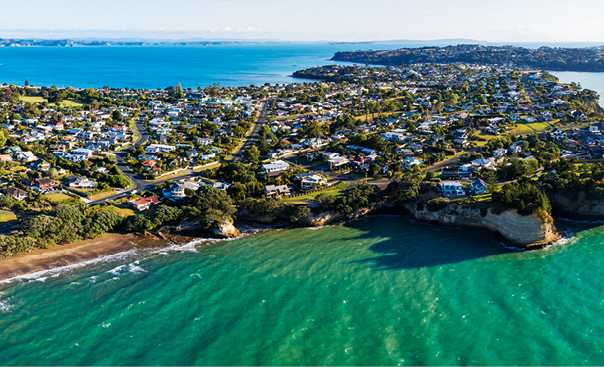
Rodney is a picturesque spot that’s experiencing upward growth.

The Northern Gateway Toll Road.
1 Auckland: Rodney And Papakura
Auckland often leads the country in house price changes, and that’s likely to be the case again in 2024. It is already leading the country on infrastructure; from the City Rail Link to hospital upgrades across the city, the investment level is immense. New Zealand’s economic powerhouse is preparing to get even bigger.
Many people left the super city during the pandemic, restricting population growth to just 7 per cent since 2017. But migration is booming, making Auckland a prime candidate for growth and high demand for rentals. A pre-Covid survey found 56 per cent of immigrants planned to settle in Auckland, according to Infometrics, so we can expect a major influx of new residents.
Within the greater Auckland area, two areas stand out with strong, positive growth: Rodney to the north (up 23 per cent since 2017) and Papakura to the south (up 29 per cent). This demonstrates a typical pattern of value change, where buyers radiate outwards from popular expensive suburbs into nearby more affordable areas.
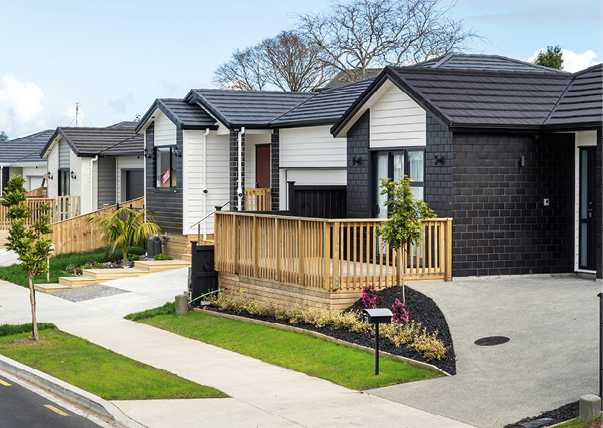
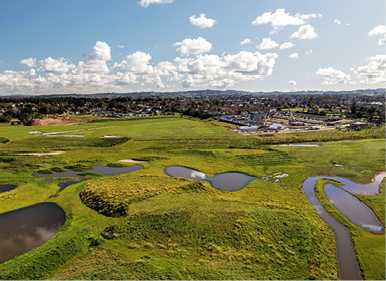
Bellfield Estate is a new area being developed in the heart of Papakura. All sections are sold and the buildings in stage one have been completed (see above). The upgrading of infrastructure in the region makes this area one to watch - the values in Papakura have risen 29 per cent since 2017. The drone shot below shows the extent of the area that will be developed.
2 Whangarei
Auckland has an average house price of around $1.26 million. Just a two-hour drive away, Whangarei looks brilliantly affordable by comparison. Several suburbs have medians in the $500,000 to $600,000 range, and the average house price is $730,000.
Population growth has been steady, at 11 per cent, and the considerable infrastructure investment will support plenty of new residents. A billion-dollar hospital rebuild is under way, which will employ 500 during construction and be a major employer once completed. In June last year, the Pūhoi to Warkworth motorway opened, cutting 11 minutes off the trip between Auckland and Warkworth. Longer-term, a four-lane highway through to Whangarei is also likely, strengthening the connections between Northland and Auckland. Now could be the time to buy.

Whangarei has always punched below its weight when it comes to price. Several suburbs in this northern city have values of between $500,000 and $600,000 with the average house price being $730,000 across the region.
“They key thing is that prices in Whangarei are really good value compared to the rest of the country,” says Jenny Martin, brand and territory owner, Mike Pero Whangarei. “If you’ve got $700,000 you can’t even get a sniff in Auckland these days, but up here that will get you a really good home with a good rent. I’m an investor myself and from that perspective it’s still great value. There’s demand from rental and people are moving up here all the time who are sick of the big cities.”
Martin hopes transport links will be improved, with roads widened and better back-ups when the weather causes issues. As it gets easier to drive from Auckland, Whangarei’s popularity will keep rising.
“We’ve got fabulous beaches and only a handful of traffic lights. It’s not a little hick town, it’s a solid city with a community focus. It’s a gateway to the north, and the Bay of Islands is right at your doorstep. We’ve got everything you need.”

The Selwyn district, just out of Christchurch, is an area that is likely to increase in value due to massive population growth.
3 Selwyn
Bordering Christchurch, Selwyn has seen astonishing population growth of 36 per cent between 2017 and 2023, the highest in the country and streets ahead of the national growth of 9 per cent. Council projections put the number of houses required to meet the growing population at over 1000 a year for the next 30 years.
While many of Christchurch’s suburbs have median values over the $1 million mark, Selwyn has much more affordable areas. Darfield, for instance, was one of the few suburbs to grow in value (very slightly) over the past 12 months, reaching a median of around $640,000. Rolleston is priced just under $800,000; Kirwee at around $730,000.
A $150 million retirement village is planned for Selwyn, along with thousands of new homes, sports facilities and a new wastewater plant. Construction on the $125 million Rolleston flyover is scheduled to begin in 2026.
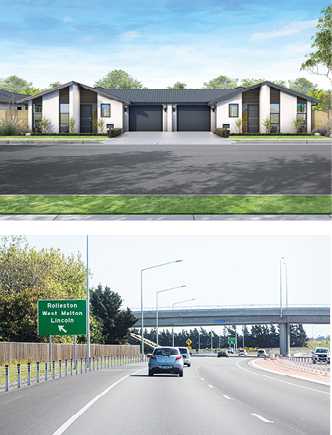
TOP A render of a new home in The Crossing, a Rolleston development.
BOTTOM Rolleston is the largest town in the Selwyn district.
Micky Limmer, head of property at OPES Partners, has been active in the Selwyn market for years. He recently resold a property purchased by an investor client seven years ago – originally bought for $420,000. It resold for $775,000. He says that’s a reflection of the area’s enormous appeal, driven by all-new amenities, value-for-money modern homes and a friendly community of renters and owner-occupiers.
“Selwyn is a shining light in the New Zealand market,” Limmer says. “All the development has meant the District Council has money to spend, and they’ve been able to build amazing facilities. Just look at Rolleston: the council built a beautiful big new aquatic centre, and six months after opening it they went on to do an extension. People want to move out here. Everybody’s been surprised by the growth.”
4 Waipa
South of Hamilton, Waipa is benefitting from that city’s growing popularity. Waipa has experienced solid population growth of 14 per cent since 2017, with well-regarded Cambridge leading the way.
Major housing developments and roadworks have helped draw Aucklanders and other relocators to Cambridge, which now has a median house price of just over $1 million. Twenty minutes’ drive south, Te Awamutu is still relatively affordable with a median house price of just over $700,000, and another seven minutes south is Kihikihi, with its median price a nudge under $680,000.
The local council has forecast a need for 212 more homes in Cambridge every year until 2050 to meet the demands of a growing population, with Te Awamutu and Kihikihi also needing 100 extra homes between them annually. Land is already set aside in Te Awamutu for a new transport corridor (although it remains unconfirmed) and the council has a capital works programme underway worth $126.8 million.
“Over the past three or four years a lot of people have been priced out of Cambridge and they’ve drifted over to Te Awamutu,” says Ian Jones, an experienced sales consultant at LJ Hooker in Te Awamutu. “They can buy a house here considerably cheaper than they can in Cambridge.”
New estates are popping up and selling strongly, says Jones. A brand new three-bedroom, two-bathroom home that might have sold in the $600,000s four years ago is now going on the market at around $1 million to $1.1 million. And the population growth has been noticeable: “Try going anywhere between 4.30 and 5pm,” he laughs. “Traffic jams in Te Awamutu!”
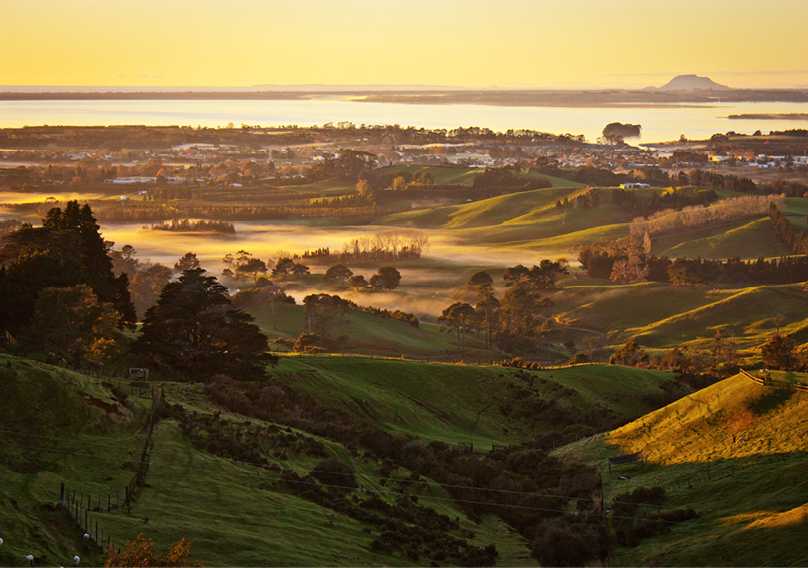
Katikati is a beautiful town in the Western Bay of Plenty. This area is benefitting from Tauranga’s continued popularity with home buyers.
5 Western Bay of Plenty
Tauranga just keeps drawing new residents, driving up property prices and populations in all the adjacent areas. Around half of all Tauranga’s suburbs have median prices of $1 million or more, compared to Western Bay of Plenty’s Katikati ($756,000), Te Puke ($738,000) and Paengaroa ($718,000).
The population of Western Bay of Plenty has grown an impressive 19 per cent since 2017, a rate slightly higher than Tauranga’s 18 per cent. Extensive developments are planned for the area, including the proposed ‘Tauriko for Tomorrow’, along with major roading projects, retail and schools.
“Western Bay of Plenty benefits from what’s happening along the Bay of Plenty coastline, which has a lot to do with the golden triangle,” says David Martin, of Bayleys Bay of Plenty. The “golden triangle” describes Auckland, Hamilton and Tauranga and the area contained by that triangle. “If we look at that area, 44 per cent of New Zealand’s population lives in urban areas within that space and 52 per cent of residential consents are contained within that space.”
Going a little further from Tauranga means people can afford a larger property and often a better-quality home. Even with the cost of fuel rising, people are happy to make the trade-off of a longer commute into work, “and as the roads improve, that commute becomes negligible,” adds Martin.
Sources: Median house prices from CoreLogic, October 2023. Population data from Stats NZ.


